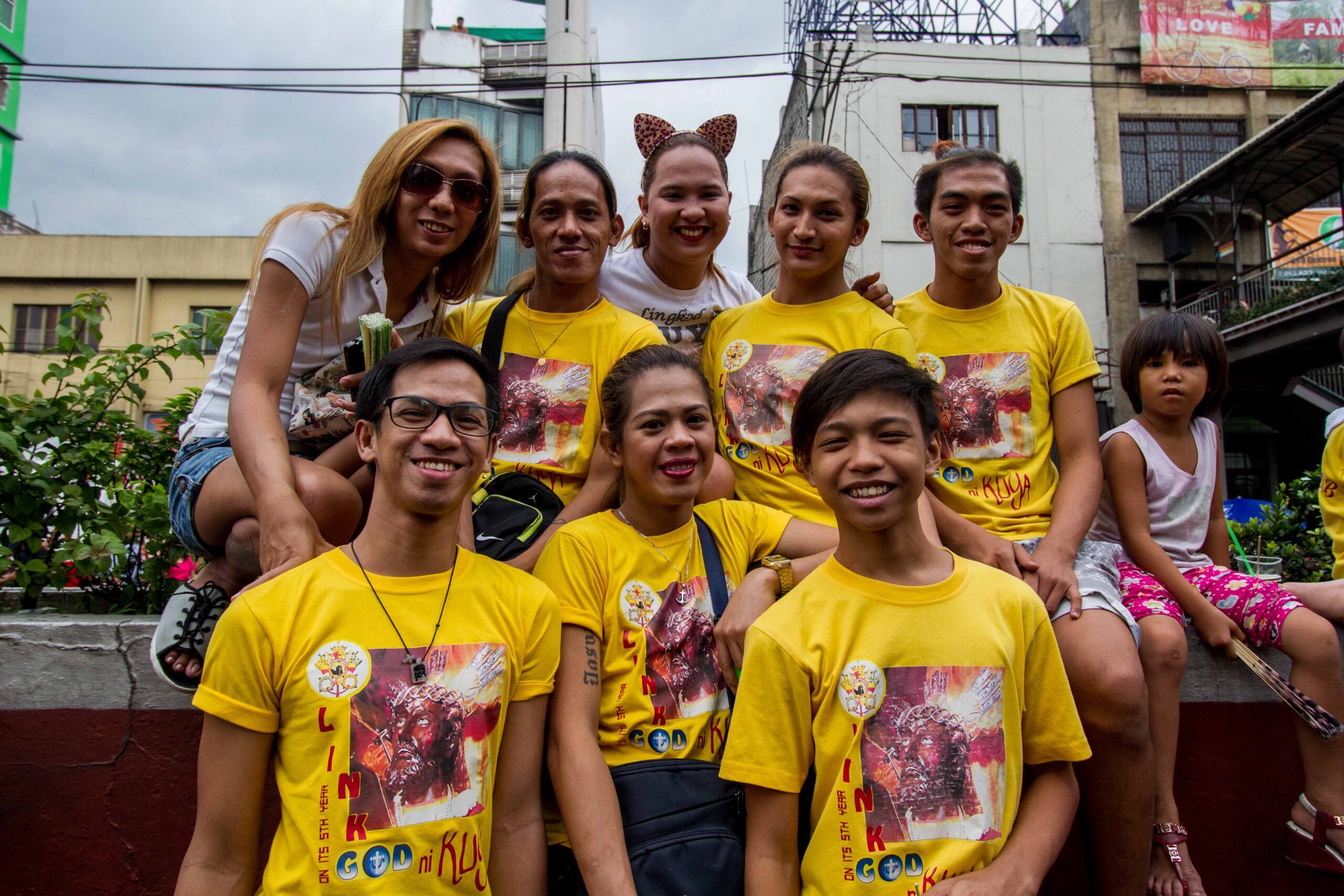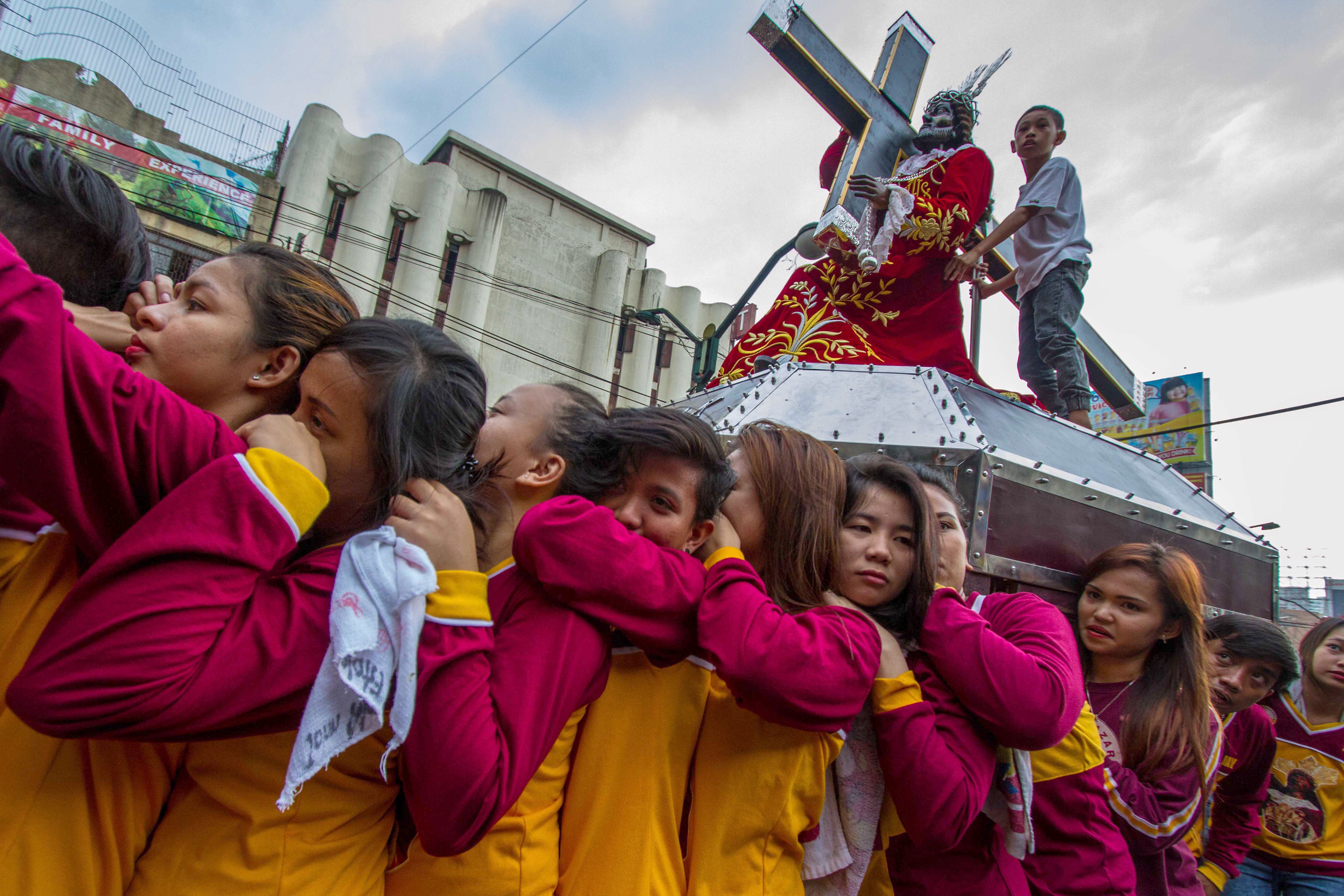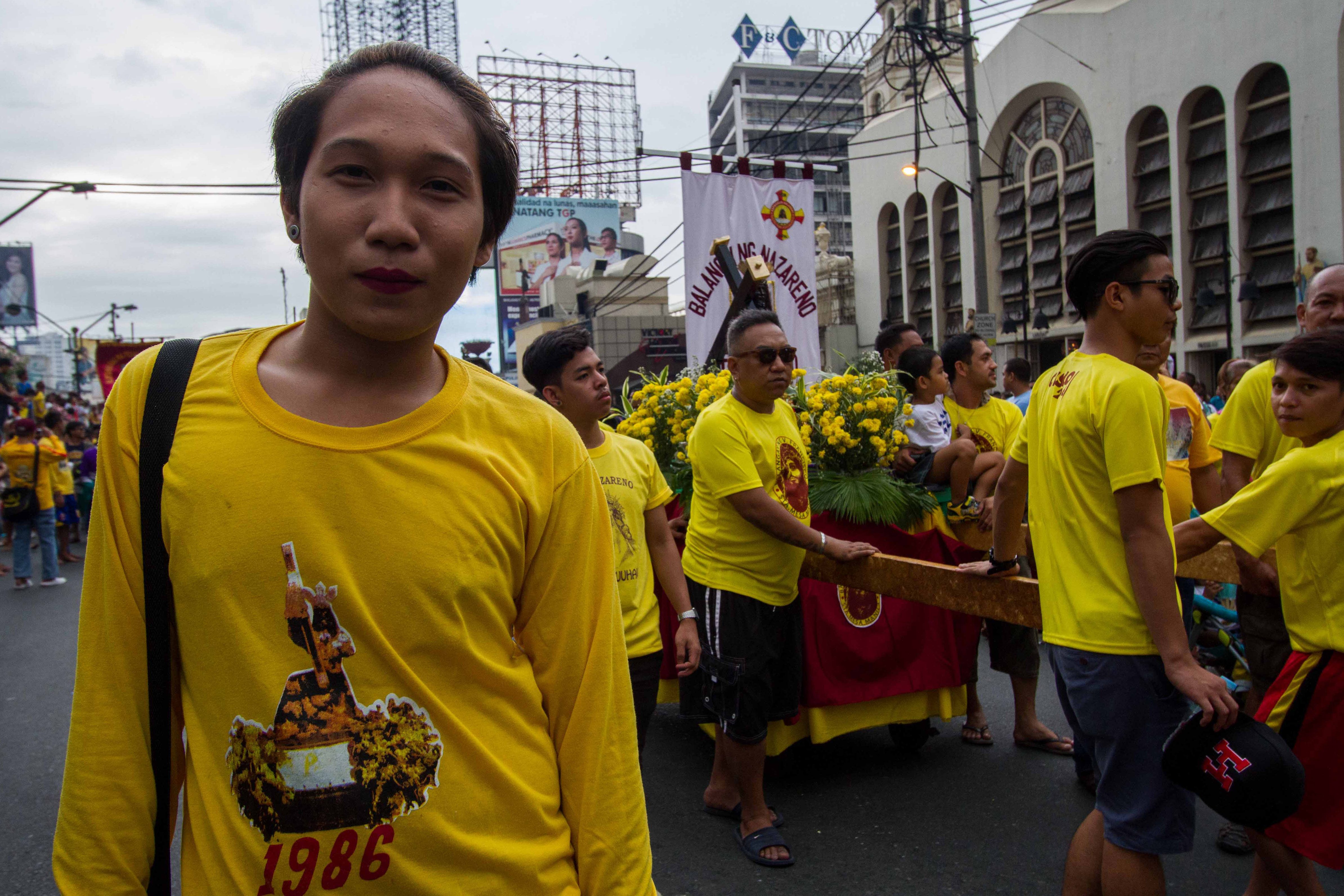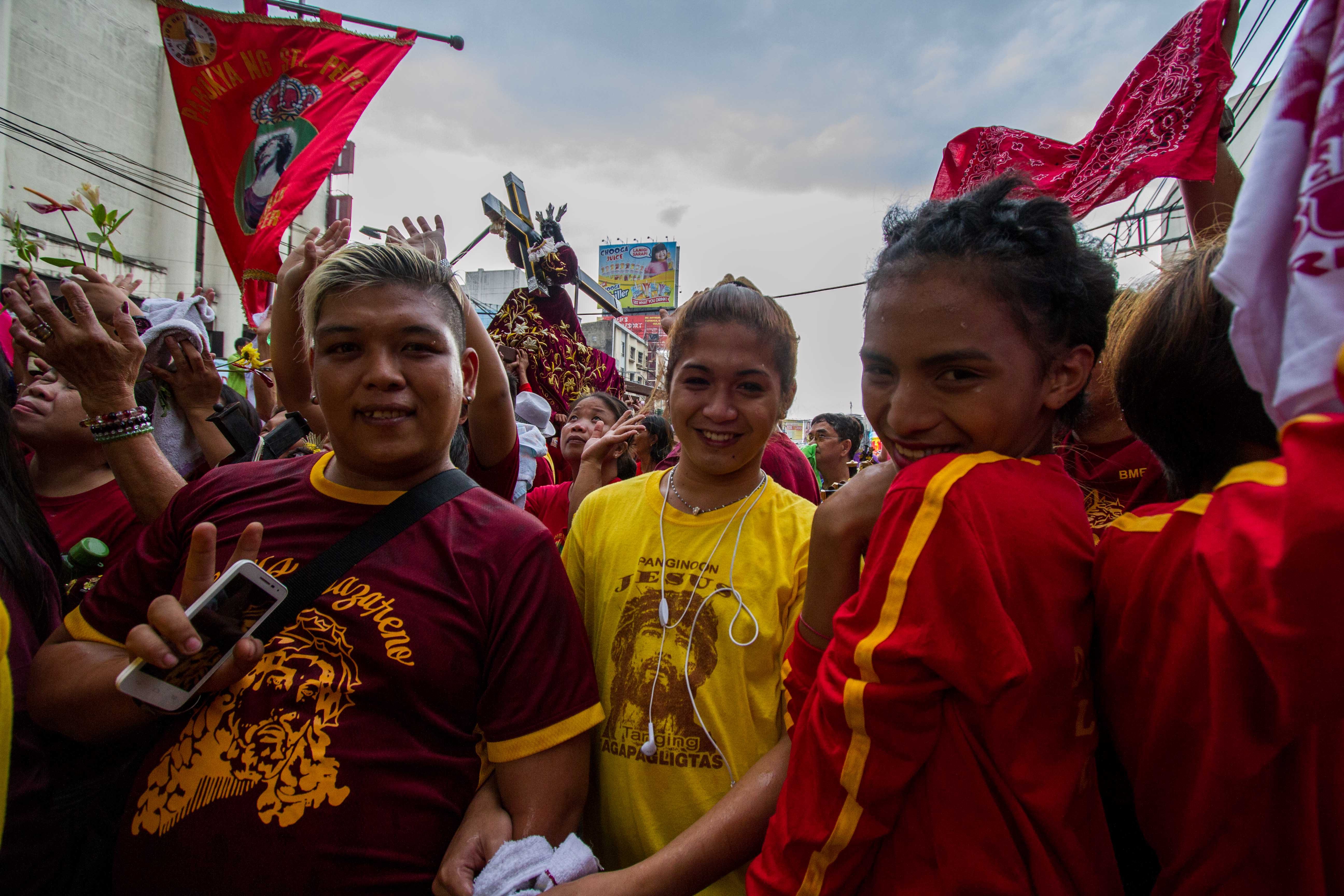SUMMARY
This is AI generated summarization, which may have errors. For context, always refer to the full article.

MANILA, Philippines — It was a big day for 36-year-old Zoren Cruz of Bambang, Sta Cruz in Manila. For 10 years, he always prepared for the 7th of January, when the procession of the replicas of the Black Nazarene takes place on the grounds of Quiapo.
He shaved his face and put colors on it and on his lips. He wore his skinny jeans and a printed yellow t-shirt with an image of the charred Christ on it, but he left behind his slippers. He was going to meet his gay friends barefoot.
Zoren is gay and a devotee of the Black Nazarene.
“I am doing this to profess my faith. I believe it washes away my sins,” said Zoren.
Zoren added that every year, he and his friends join the procession together. They even help carry the Poon, a medium size replica of the Black Nazarene during the entire parade.
“It became my vow to serve the Black Nazarene and thank Him for everything He has given me,” added Zoren.
On the other side of the road, where Zoren and his friends were waiting for the procession to commence, was Patrick Verona who came alone to join the march of the replicas. The 19 year-old Sampaloc resident said he has been a devotee for 7 years.
“I started when I was just 12. I remember that, every year, my father always brought me to Quiapo to join the procession of replicas and the Translacion,” said Patrick.
“I think I was influenced by my parents. They are solid followers, too, of the Poon Nazareno. I grew up in a Catholic family and I saw how important faith is,” added Patrick.
The Translacion of the Black Nazarene every 9th of January is a highly anticipated religious event in the country with attendees reaching up to 12 million. Devotees believe that the centuries-old wooden life-size statue of Jesus Christ is miraculous.
According to the National Shrine of the Black Nazarene rector Msgr Hernando Coronel, the occasion is not just a local event but a national celebration because of the devotees coming from all parts of the country.
“Millions and millions of devotees are coming in this year’s procession of the Black Nazarene. Our experience here in the Philippines is that the number of devotees increase each year,” said Msgr. Coronel during a press conference days before the procession of the replicas.
Patriarchy of the feasts
For many years, the Traslacion of the Black Nazarene is known to be patriarchal in nature. It is predominated by male faithfuls because of the physical requisites of the procession itself.
The Traslacion notorious of the casualties that result from the jostling and congestion of the crowd pulling the “Andas.”
It had been a tradition that only men can join the Traslacion because people believed the women cannot endure the combination of heat, fatigue, and being trampled upon by other devotees, which have caused injuries and deaths in the past.
“We can also do it. If they would just allow us to carry the Andas, we could show them that even women are capable of it,” said Renalyn Macarandang, a 37-year old mother from Tanay, Rizal.

Renalyn claimed that even in their own community, women devotees experience discrimination in demonstrating their faith, until they were allowed to carry the replica during its procession.
However, according to the Ateneo de Manila University’s Development Studies Program Director Jayeel Serrano Cornelio, it has always been a male-dominated event because of its rowdy nature, and physical and masculine space. (READ: LGBT Nazareno devotees: ‘We are Christians too!’)
“The Traslacion of the Black Nazarene requires masculine endurance. Religious piety of Filipinos, in many ways, is much gendered. While the feast of the Black Nazarene is so masculine, the Flores de Mayo is a feminine space.
“But it is not just in religion that gender division happens. It also takes place in cultural practices, like the Mumbaki for Ifugaos,” Cornelio stressed.
Anti-LGBT outlook
Like Renalyn, Zoren and Patrick claimed that they experienced discrimination not only from other devotees but from some church leaders. (READ: CBCP on anti-discrimination bill: Gender is ‘God’s gift’)
“They looked at us like we were sinners, as if we were not welcome to join the event. We may be gays but we also have the right to practice faith as Catholics,” said Zoren.
Over the last few years, the Catholic Church has become more open to welcoming the LGBT community. Pope Francis said, “If someone is gay and searches for the Lord and has good will, who am I to judge?”
Pope Francis’ statement shocked the Church and international community. His statement was in contrast to his predecessor, Pope Emeritus Benedict XVI, who said gay marriage was a threat to global peace.
For Cornelio, Pope Francis’ statement was clearly saying that we should embrace the sinner but condemn the sin.
“The Pope’s position is still very reflective of the stand of the Church that homosexuality is not a sin but ‘homosexualism’ is a sin,” said Cornelio.
“It is the sexual act that makes the people a sinner. So the Church always says that they can accept the sinner but not the sin,” added Cornelio.
According to Cornelio, it is an interesting development that more LGBT members participate because the feast of the Black Nazarene is actually not an LGBT space.

“But at the same time, in recent years, there are observations that women play a big role in the celebration of the translacion. The LGBT community is also empowered to do the same thing,” said Cornelio.
Patrick believed that the LGBT community is very much involved in many religious activites, not just during the feast of the Poon.
“Many members of the gay community are very active in handling religious events. They are the ones who make beautiful designs for the Santacruzan event. They even make dresses for the statues or make clothes for the Itim na Nazareno,” said Patrick.
Authentic religious practice
It was very clear for Zoren, Patrick and Renalyn why they joined the procession and vowed to the Black Nazarene as devotees.

They participate because they believe that the “Charred Christ” gives them hope and strengthens them to face the tests and struggles in life.
“I became a devotee because of my sick father. Ten years ago I asked the Itim na Poon to heal my father who suffered from tuberculosis. He granted my prayers,” said Renalyn.
“Whoever and whatever a devotee is, an LGBT member, a woman or a man who devotes his or her time and effort to show his or her faith is practicing an authentic religiosity,” said Cornelio.
“Gender is not an issue anymore to religious events like the feast of the Black Nazarene. It is how Catholics express their faith even in a form of ‘popular religiosity’ but ‘one of the most effective bearers of faith’ like what the Manila Archbishop Luis Antonio Cardinal Tagle had expressed,” Cornelio concluded. – Rappler.com
Add a comment
How does this make you feel?
There are no comments yet. Add your comment to start the conversation.